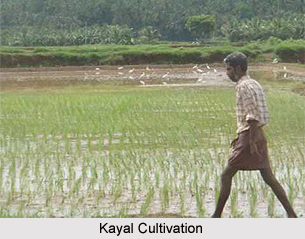 Kayal cultivation in Kerala is a significant occupation in Kuttanad. Farming forms a significant occupation of the state. Rice happens to be an essential agricultural product, giving Kuttanad the moniker of "The Rice Bowl of Kerala". Presently, every year there are three types of crops that are grown, instead of the conventional two per year. Large scale farming area near Vembanad Lake was actually reclaimed from the lake. The history of the Kayal cultivation in Kuttanad can be traced back to centuries.
Kayal cultivation in Kerala is a significant occupation in Kuttanad. Farming forms a significant occupation of the state. Rice happens to be an essential agricultural product, giving Kuttanad the moniker of "The Rice Bowl of Kerala". Presently, every year there are three types of crops that are grown, instead of the conventional two per year. Large scale farming area near Vembanad Lake was actually reclaimed from the lake. The history of the Kayal cultivation in Kuttanad can be traced back to centuries.
The progress of paddy cultivation in Kuttanad was correlated to the changes and advancement of technology in the regulatory framework existed during 19th and 20th centuries. In the initial times, the reclamation was done mainly from the shallow part of the Vembanad Lake or from the periphery of river Pamba. This reclamation actually formed the small areas of paddy field known as "Padsekharams". Sweeping out of the water from these fields were manually done using wheels named "Chakram". Slowly the manual method were used for bailing out of water gave way to steam engines.
The `Pattom Proclamation` made by the Travencore Kingdom in the year 1865, gave a great boost to the reclamation activities during the years 1865 to1890. The Venad Kayal which was reclaimed during this very period is also considered as first Kayal Nilam which was reclaimed from the Vembanad Lake. This revolutionary reclamation activity of Kayal Cultivation was made by two brothers (Mathai Luka Pallithanam and Ouseph Luka Pallithanam) belonging to Kainady village in Kuttanadu. The period between 1865 and 1890 is usually considered as the first phase of Kayal Cultivation.
The introduction of Kerosene Engines for dewatering also resulted in the getting back of wider areas of the lake for cultivation. It also made the farmers to think of going into the deeper parts of the lake. The period between 1898 and 1903 was a time when reclamation activity was led by Pallithanam Luka Mathai (alias Pallithanathu Mathaichen) who reclaimed the Cherukara Kayal, Pallithanam Moovayiram Kayal, and Madathil Kayal. But second phase (1890 to 1903) of reclamation activities came to a halt because of the ban on Kayal reclamation imposed by the Madras Government in 1903.
The prominent families in Kuttanad who were involved in the backwater paddy cultivation are Pallithanam, Vallickadu, Vachaparampil, Pazhayaparmpil, Punnadamvakkal, Chalayil, Kandakudy, Illikalam, Akkara, Ettuparayil, Mangalapallil, Paruthickal, Meledom, Murukkummootil, Puthenpurayil, Pattasseril etc.
As the farming in the area increased farmers felt they were constrained by the two cycles a year for rice cultivation. The reason for which is the limited availability of potable water in Kuttanadu. During the monsoon seasons, the water from the mountains flow through the rivers to the sea, bringing potable water to Kuttanadu. But during summer, due to the low level of the region, seawater enters Kuttanadu and makes the salt content of the water high making it unpotable.
This article is a stub. You can enrich by adding more information to it. Send your Write Up to content@indianetzone.com



















